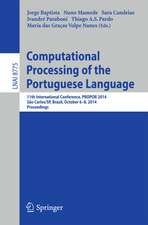Topology of Digital Images: Visual Pattern Discovery in Proximity Spaces: Intelligent Systems Reference Library, cartea 63
Autor James F. Petersen Limba Engleză Hardback – 14 feb 2014
| Toate formatele și edițiile | Preț | Express |
|---|---|---|
| Paperback (1) | 651.89 lei 43-57 zile | |
| Springer Berlin, Heidelberg – 27 aug 2016 | 651.89 lei 43-57 zile | |
| Hardback (1) | 656.69 lei 43-57 zile | |
| Springer Berlin, Heidelberg – 14 feb 2014 | 656.69 lei 43-57 zile |
Din seria Intelligent Systems Reference Library
- 20%
 Preț: 1050.57 lei
Preț: 1050.57 lei - 20%
 Preț: 1157.60 lei
Preț: 1157.60 lei - 20%
 Preț: 648.44 lei
Preț: 648.44 lei - 20%
 Preț: 650.08 lei
Preț: 650.08 lei - 20%
 Preț: 1005.64 lei
Preț: 1005.64 lei - 20%
 Preț: 1052.67 lei
Preț: 1052.67 lei - 20%
 Preț: 1171.46 lei
Preț: 1171.46 lei - 20%
 Preț: 1164.84 lei
Preț: 1164.84 lei - 20%
 Preț: 815.83 lei
Preț: 815.83 lei - 20%
 Preț: 989.96 lei
Preț: 989.96 lei - 20%
 Preț: 1063.41 lei
Preț: 1063.41 lei - 20%
 Preț: 504.37 lei
Preț: 504.37 lei - 18%
 Preț: 1113.26 lei
Preț: 1113.26 lei - 20%
 Preț: 1920.04 lei
Preț: 1920.04 lei - 20%
 Preț: 990.62 lei
Preț: 990.62 lei - 20%
 Preț: 651.57 lei
Preț: 651.57 lei - 20%
 Preț: 645.97 lei
Preț: 645.97 lei - 20%
 Preț: 660.16 lei
Preț: 660.16 lei - 20%
 Preț: 647.13 lei
Preț: 647.13 lei - 20%
 Preț: 654.05 lei
Preț: 654.05 lei - 20%
 Preț: 649.93 lei
Preț: 649.93 lei - 20%
 Preț: 648.11 lei
Preț: 648.11 lei - 20%
 Preț: 657.99 lei
Preț: 657.99 lei - 20%
 Preț: 656.84 lei
Preț: 656.84 lei - 20%
 Preț: 1624.04 lei
Preț: 1624.04 lei - 20%
 Preț: 642.98 lei
Preț: 642.98 lei - 20%
 Preț: 649.60 lei
Preț: 649.60 lei - 20%
 Preț: 651.23 lei
Preț: 651.23 lei - 20%
 Preț: 653.06 lei
Preț: 653.06 lei - 20%
 Preț: 1002.99 lei
Preț: 1002.99 lei - 20%
 Preț: 645.14 lei
Preț: 645.14 lei - 20%
 Preț: 658.33 lei
Preț: 658.33 lei - 20%
 Preț: 644.98 lei
Preț: 644.98 lei - 20%
 Preț: 646.62 lei
Preț: 646.62 lei - 20%
 Preț: 654.21 lei
Preț: 654.21 lei
Preț: 656.69 lei
Preț vechi: 820.86 lei
-20% Nou
Puncte Express: 985
Preț estimativ în valută:
125.67€ • 130.41$ • 105.04£
125.67€ • 130.41$ • 105.04£
Carte tipărită la comandă
Livrare economică 17-31 martie
Preluare comenzi: 021 569.72.76
Specificații
ISBN-13: 9783642538445
ISBN-10: 3642538444
Pagini: 420
Ilustrații: XVI, 411 p. 250 illus., 158 illus. in color.
Dimensiuni: 155 x 235 x 30 mm
Greutate: 0.73 kg
Ediția:2014
Editura: Springer Berlin, Heidelberg
Colecția Springer
Seria Intelligent Systems Reference Library
Locul publicării:Berlin, Heidelberg, Germany
ISBN-10: 3642538444
Pagini: 420
Ilustrații: XVI, 411 p. 250 illus., 158 illus. in color.
Dimensiuni: 155 x 235 x 30 mm
Greutate: 0.73 kg
Ediția:2014
Editura: Springer Berlin, Heidelberg
Colecția Springer
Seria Intelligent Systems Reference Library
Locul publicării:Berlin, Heidelberg, Germany
Public țintă
ResearchCuprins
Preface.-
1 Topology of Digital Images: Basic Ingredients.-
2 Structures Arising from Sets of Pixels.-
3 Visualisations and Covers.-
4 Linear Filtering and Visual Patterns in Images.-
5 Edges, Lines, Ridges, and Nearness Structures.-
6 Corners and Symmetric Proximity.-
7 Separation of Image Regions and Set Patterns.-
8 Descriptive Raster Spaces.-
9 Component Analysis and Uniform Spaces.-
10 Shapes and Shape Set Patterns.-
11 Texture and Texture Set Patterns.-
12 Pattern-Based Picture Classification.-
13 Appendix: Matlab and Mathematica Scripts.-
14 Notes and Further Readings.
1 Topology of Digital Images: Basic Ingredients.-
2 Structures Arising from Sets of Pixels.-
3 Visualisations and Covers.-
4 Linear Filtering and Visual Patterns in Images.-
5 Edges, Lines, Ridges, and Nearness Structures.-
6 Corners and Symmetric Proximity.-
7 Separation of Image Regions and Set Patterns.-
8 Descriptive Raster Spaces.-
9 Component Analysis and Uniform Spaces.-
10 Shapes and Shape Set Patterns.-
11 Texture and Texture Set Patterns.-
12 Pattern-Based Picture Classification.-
13 Appendix: Matlab and Mathematica Scripts.-
14 Notes and Further Readings.
Recenzii
From the reviews:
“This book presents the recent research results of visual patterns in proximity spaces in a very easy to follow way. … a research exposition for mathematicians, computer scientists, engineers and for all who want to familiarize with the recent research in this field. It can be also treated as the textbook for students and for all who want to deeply understand images through their topology. It can be used for a self studying and as a course book as well.” (Agnieszka Lisowska, zbMATH, Vol. 1295, 2014)
“This book presents the recent research results of visual patterns in proximity spaces in a very easy to follow way. … a research exposition for mathematicians, computer scientists, engineers and for all who want to familiarize with the recent research in this field. It can be also treated as the textbook for students and for all who want to deeply understand images through their topology. It can be used for a self studying and as a course book as well.” (Agnieszka Lisowska, zbMATH, Vol. 1295, 2014)
Textul de pe ultima copertă
This book carries forward recent work on visual patterns and structures
in digital images and introduces a near set-based a topology of digital
images. Visual patterns arise naturally in digital images viewed as sets
of non-abstract points endowed with some form of proximity (nearness)
relation. Proximity relations make it possible to construct uniform topolo-
gies on the sets of points that constitute a digital image. In keeping with
an interest in gaining an understanding of digital images themselves as a
rich source of patterns, this book introduces the basics of digital images
from a computer vision perspective. In parallel with a computer vision
perspective on digital images, this book also introduces the basics of prox-
imity spaces. Not only the traditional view of spatial proximity relations
but also the more recent descriptive proximity relations are considered.
The beauty of the descriptive proximity approach is that it is possible to
discover visual set patterns among sets that are non-overlapping and non-
adjacent spatially. By combining the spatial proximity and descriptive<
proximity approaches, the search for salient visual patterns in digital im-
ages is enriched, deepened and broadened. A generous provision of Matlab
and Mathematica scripts are used in this book to lay bare the fabric and
essential features of digital images for those who are interested in finding
visual patterns in images. The combination of computer vision techniques
and topological methods lead to a deep understanding of images.
in digital images and introduces a near set-based a topology of digital
images. Visual patterns arise naturally in digital images viewed as sets
of non-abstract points endowed with some form of proximity (nearness)
relation. Proximity relations make it possible to construct uniform topolo-
gies on the sets of points that constitute a digital image. In keeping with
an interest in gaining an understanding of digital images themselves as a
rich source of patterns, this book introduces the basics of digital images
from a computer vision perspective. In parallel with a computer vision
perspective on digital images, this book also introduces the basics of prox-
imity spaces. Not only the traditional view of spatial proximity relations
but also the more recent descriptive proximity relations are considered.
The beauty of the descriptive proximity approach is that it is possible to
discover visual set patterns among sets that are non-overlapping and non-
adjacent spatially. By combining the spatial proximity and descriptive<
proximity approaches, the search for salient visual patterns in digital im-
ages is enriched, deepened and broadened. A generous provision of Matlab
and Mathematica scripts are used in this book to lay bare the fabric and
essential features of digital images for those who are interested in finding
visual patterns in images. The combination of computer vision techniques
and topological methods lead to a deep understanding of images.
Caracteristici
Introduction to the basics of digital images that are viewed as topological spaces Offers a complete entry-level study of digital image processing and the analysis of digital images that are structured sets Includes various Matlab examples




























